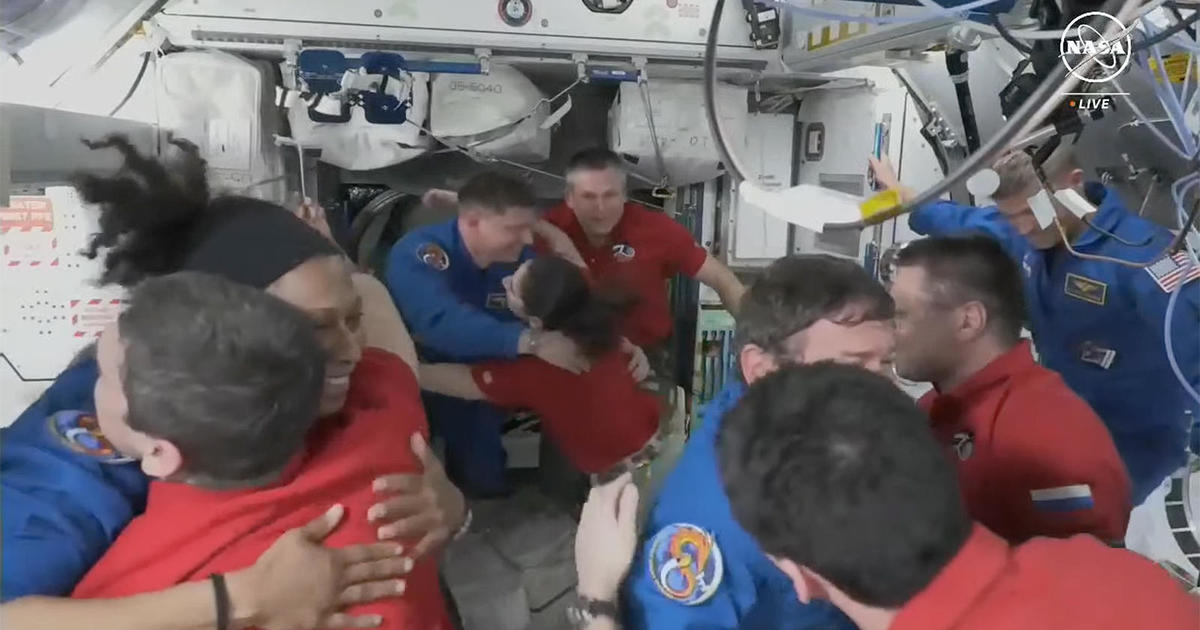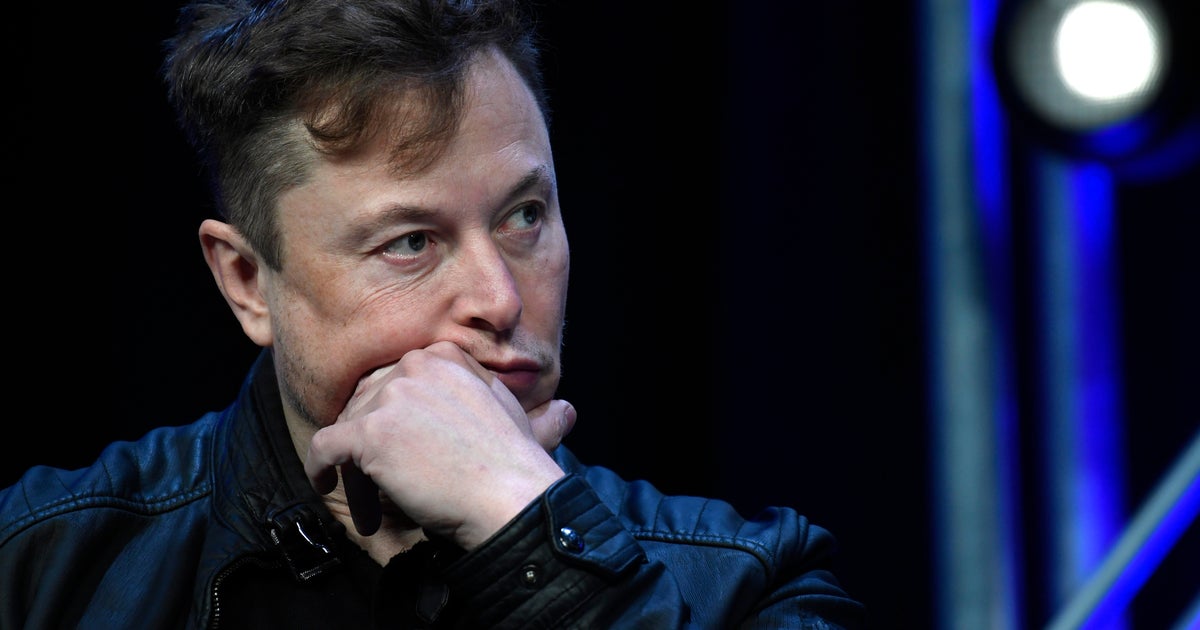CBS News
Crew Dragon docks with space station, bringing four fresh crew members to the outpost

A SpaceX Crew Dragon spacecraft caught up with the International Space Station early Tuesday after a 28-hour orbital chase, bringing three NASA astronauts and a Russian cosmonaut to the outpost for a six-month tour of duty.
The docking capped an exceptionally busy “day” for SpaceX that included the Crew Dragon’s launch Sunday at 10:53 p.m. EST, followed by two back-to-back Falcon 9 flights Monday, one from Florida and the other from California, that put a total of 76 satellites into orbit.
All the while, the Crew Dragon, launched three days late because of high winds, continued its automated approach to the space station, catching up from behind and below and then moving in for docking at the Harmony module’s forward port at 2:28 a.m. EST Tuesday, about a half hour earlier than expected.
NASA TV
After hooks drove home to firmly lock the spacecraft in place, a SpaceX flight controller called to confirm “docking sequence is complete. So with that, Crew Dragon Endeavour, welcome to the International Space Station. We would also like to note that you can’t be ‘Crew L8’ (late) when you arrive 30 minutes early.”
“SpaceX Dragon … copies all,” Crew 8 commander Matthew Dominick replied. “So excited to be here, and thank you, all the teams that got us here, so much.”
Dominick, space station veteran Mike Barratt, Jeanette Epps and Russian cosmonaut Alexander Grebenkin are replacing Crew 7 commander Jasmin Moghbeli, European Space Agency astronaut Andreas Mogensen, Japanese flier Satoshi Furukawa and cosmonaut Konstantin Borisov. They plan to undock March 11 to close out their own six-month stay in space.
NASA TV
“From those of us on board, welcome to the International Space Station,” Moghbeli radioed after Crew 8 docked. “Mike, welcome back. We think a few things have changed since you left. Matt, Jeanette, Sasha, you’re going to absolutely love it here.”
“Good to hear your voice, Jasmin, and looking forward to seeing you in just a moment,” Dominick replied.
“Absolutely,” Moghbeli said. “I’m both excited and sad, because it means I’m leaving soon.”
After leak checks to verify an airtight structural seal, hatches were opened and the Crew 8 fliers floated into the space station to be welcomed aboard by Moghbeli’s crew and three other station crew members who flew to the lab aboard a Russian Soyuz spacecraft: commander Oleg Kononenko, Nikolai Chub and NASA astronaut Loral O’Hara.
“Welcome to space, Matt, Jeannette and Alex, and welcome back to space to Mike,” said Mogensen, the outgoing space station commander. “You guys are going to have a fantastic mission, and we look forward to spending the next week in space with you.”
NASA TV
Dominick said his crew was “super excited to be here.”
“Thank you to everyone who helped put this together,” he said, “such a giant team around the world, and we’re excited to be on board and ready to take over the watch.”
Barratt, making his third space flight and his second long-duration visit to the station, said it was great to be back, adding “our flight’s gonna go by in the blink of an eye, and I’m really anxious to start. Thanks for the very warm welcome.”
Crew 7 will spend nearly a week familiarizing their replacements with the intricacies of space station operations before undocking and returning to Earth.
Kononenko, Chub and O’Hara were launched last September. The two cosmonauts are midway through a yearlong stay aboard the space station while O’Hara is wrapping up a more typical six-month tour.
On March 21, a fresh Soyuz will be delivered to the space station by veteran cosmonaut Oleg Novitskiy, Belarus guest flier Marina Vasilevskaya and NASA veteran Tracy Dyson.
Then, on April 2, Novitskiy and Vasilevskaya will return to Earth along with NASA’s O’Hara, using the Soyuz spacecraft that carried Kononenko, Chub and O’Hara to the station last September.
Dyson will return to Earth next September, joining Kononenko and Chub aboard the Soyuz MS-25/71S spacecraft delivered by Novitskiy.
CBS News
The Menendez Brothers’ Fight for Freedom

Watch CBS News
Be the first to know
Get browser notifications for breaking news, live events, and exclusive reporting.
CBS News
9/28: CBS Weekend News – CBS News

Watch CBS News
Be the first to know
Get browser notifications for breaking news, live events, and exclusive reporting.
CBS News
California Gov. Gavin Newsom vetoes bill requiring speeding alerts in new cars

California Gov. Gavin Newsom vetoed a bill Saturday that would have required new cars to beep at drivers if they exceed the speed limit in an effort to reduce traffic deaths.
California would have become the first to require such systems for all new cars, trucks and buses sold in the state starting in 2030. The bill would have mandated that vehicles beep at drivers when they exceed the speed limit by at least 10 mph.
The European Union has passed similar legislation to encourage drivers to slow down. California’s proposal would have provided exceptions for emergency vehicles, motorcycles and motorized scooters.
In explaining his veto, Newsom said federal law already dictates vehicle safety standards and adding California-specific requirements would create a patchwork of regulations.
The National Highway Traffic Safety “is also actively evaluating intelligent speed assistance systems, and imposing state-level mandates at this time risks disrupting these ongoing federal assessments,” the Democratic governor said.
Opponents, including automotive groups and the state Chamber of Commerce, said such regulations should be decided by the federal government, which earlier this year established new requirements for automatic emergency braking to curb traffic deaths. Republican lawmakers also said the proposal could make cars more expensive and distract drivers.
The legislation would have likely impacted all new car sales in the U.S., since the California market is so large that car manufacturers would likely just make all of their vehicles comply.
California often throws that weight around to influence national and even international policy. The state has set its own emission standards for cars for decades, rules that more than a dozen other states have also adopted. And when California announced it would eventually ban the sale of new gas-powered cars, major automakers soon followed with their own announcement to phase out fossil-fuel vehicles.
Democratic state Sen. Scott Wiener, who sponsored the bill, called the veto disappointing and a setback for street safety.
“California should have led on this crisis as Wisconsin did in passing the first seatbelt mandate in 1961,” Wiener said in a statement. “Instead, this veto resigns Californians to a completely unnecessary risk of fatality.”
The speeding alert technology, known as intelligent speed assistance, uses GPS to compare a vehicle’s pace with a dataset of posted limits. If the car is at least 10 mph over, the system emits a single, brief, visual and audio alert.
The proposal would have required the state to maintain a list of posted speed limits, and it’s likely that those would not include local roads or recent changes in speed limits, resulting in conflicts.
The technology has been used in the U.S. and Europe for years. Starting in July, the European Union will require all new cars to have the technology, although drivers would be able to turn it off. At least 18 manufacturers including Ford, BMW, Mercedes-Benz and Nissan, have already offered some form of speed limiters on some models sold in America, according to the National Transportation Safety Board.
The National Highway and Traffic Safety Administration estimates that 10% of all car crashes reported to police in 2021 were related to speeding. This was especially a problem in California, where 35% of traffic fatalities were speeding-related — the second highest in the country, according to a legislative analysis of the proposal.
Last year the NTSB recommended federal regulators require all new cars to alert drivers when they speed. Their recommendation came after a crash in January 2022, when a man with a history of speeding violations ran a red light at more than 100 mph and struck a minivan, killing himself and eight other people.











